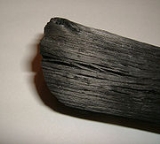
Bincho-tan
Encyclopedia
.jpg)
Charcoal
Charcoal is the dark grey residue consisting of carbon, and any remaining ash, obtained by removing water and other volatile constituents from animal and vegetation substances. Charcoal is usually produced by slow pyrolysis, the heating of wood or other substances in the absence of oxygen...
of Japan
Japan
Japan is an island nation in East Asia. Located in the Pacific Ocean, it lies to the east of the Sea of Japan, China, North Korea, South Korea and Russia, stretching from the Sea of Okhotsk in the north to the East China Sea and Taiwan in the south...
. It dates to the Edo period
Edo period
The , or , is a division of Japanese history which was ruled by the shoguns of the Tokugawa family, running from 1603 to 1868. The political entity of this period was the Tokugawa shogunate....
, when during the Genroku
Genroku
was a after Jōkyō and before Hōei. This period spanned the years from September 1688 through March 1704. The reigning emperor was .The years of Genroku are generally considered to be the Golden Age of the Edo Period. The previous hundred years of peace and seclusion in Japan had created relative...
era, a craftsman named Bitchū-ya Chōzaemon (備中屋 長左衛門) began to produce it in Tanabe, Wakayama
Tanabe, Wakayama
is the second biggest city in Wakayama Prefecture, Japan.As of 2008 , the city has an estimated population of 80,398 and a density of 78.3 persons per km². The total area is 1026.77 km². The city was founded on May 20, 1942.Tanabe is on the coast and surrounded by mountains...
. The raw material is oak
Oak
An oak is a tree or shrub in the genus Quercus , of which about 600 species exist. "Oak" may also appear in the names of species in related genera, notably Lithocarpus...
, specifically ubame oak (Quercus phillyraeoides), now the official tree of Wakayama Prefecture
Wakayama Prefecture
is a prefecture of Japan located on the Kii Peninsula in the Kansai region on Honshū island. The capital is the city of Wakayama.- History :Present-day Wakayama is mostly the western part of the province of Kii.- 1953 Wakayama Prefecture flood disaster :...
. Wakayama continues to be a major producer of high-quality charcoal, with the town of Minabe, Wakayama
Minabe, Wakayama
is a small town located in Wakayama in the Kansai region of Japan. Situated on a small bay of the Pacific ocean and surrounded by mountains, it is a quiet and picturesque farming community of about 14,000 people. Its location has been mentioned in ancient texts since the 8th century, but the basic...
producing more binchō-tan than any other town in Japan. Binchōtan is a type of Lump charcoal or Hardwood charcoal.
The fineness and high quality of binchō-tan are attributed to steaming at high temperatures (about 1000 degrees Celsius). Although it is often thought that binchō-tan burns hot, it actually burns at a lower temperature than ordinary charcoal but for a longer period of time. Because it does not release smoke or other unpleasant flavors, it is a favorite of unagi
Unagi
Unagi is the Japanese word for freshwater eels, especially the Japanese eel, Anguilla japonica. Saltwater eels are known as anago in Japanese. Unagi are a common ingredient in Japanese cooking...
and yakitori
Yakitori
, grilled chicken, is commonly a Japanese type of skewered chicken. The term Yakitori can also refer to skewered food in general. Kushiyaki , is a formal term that encompasses both poultry and non-poultry items, skewered and grilled...
cooks. Due to difficulties in identifying the producing region, the name binchō-tan has come into broader use to designate white charcoal generally, and even products from outside Japan, as well as those made of other species, have come to use the name.
To differentiate the aforementioned "non-pure" products, there is a movement to call binchō-tan produced in Wakayama kishū binchō-tan.
Binchō-tan has found uses other than as a fuel. Because it has numerous small pores, it can absorb chemical substances. Bits can be added to rice during cooking to remove chalky flavor, placed in shoe-cabinets to absorb odors, and put in rooms to freshen the air. There are many more supposed benefits and health values of white charcoal. Currently there are a number of binchō-tan-based consumer products on the market such as socks, shirts, shampoo, cosmetic products, and many more. Acclaimed London yakitori
Yakitori
, grilled chicken, is commonly a Japanese type of skewered chicken. The term Yakitori can also refer to skewered food in general. Kushiyaki , is a formal term that encompasses both poultry and non-poultry items, skewered and grilled...
restaurant Bincho
Bincho
Bincho, also known as Bincho Yakitori, is a London-based Japanese restaurant styled on the traditional izakayas found throughout Japan. Yakitori, literally translated as "grilled bird", is prepared on skewers and cooked over dense coals known as Bincho-tan made from Oak...
takes its name from binchō-tan.
Binchō-tan or white charcoal is harder than black charcoal, and rings with a metallic sound when struck. Wind chimes and a musical instrument, the tankin ("charcoal-xylophone
Xylophone
The xylophone is a musical instrument in the percussion family that consists of wooden bars struck by mallets...
") have been made from it.
- "Charcoal Adds to the Good Life" – an article from 2001 touting the benefits of black and white charcoal, the latter including binchōtan

